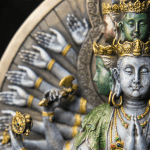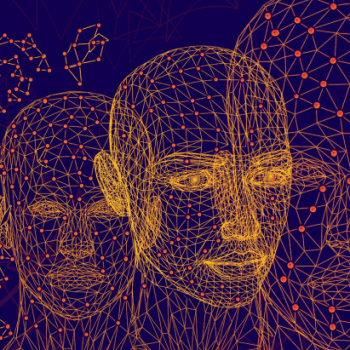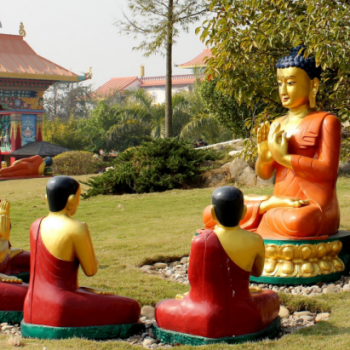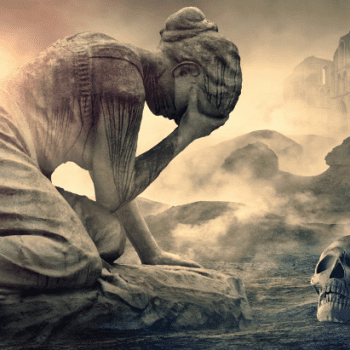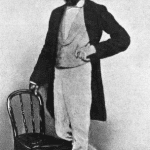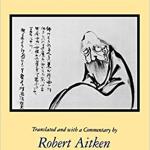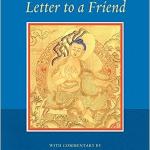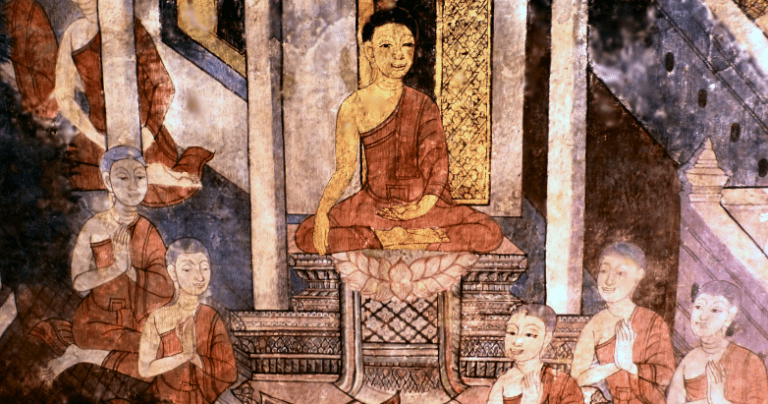
The Buddha, like Jesus and Socrates, never wrote anything down. So how do we know what the Buddha taught? The answer might surprise you.
So what does it mean that we don’t have the words of Buddha, Jesus, or Socrates? It means that we have to rely on what others say that they said. For example, the Gospel of Luke is what Luke says Jesus said. But since he didn’t know Jesus in his earthly life, he had to go by what others “handed down to” him (Luke 1:2 NIV). So what we really have is Luke telling us what others told him, and some of these may have heard them from others, who hear them from others, etc. Something similar happened with the Buddha, with a few exceptions.
In the Beginning
Siddhattha Gotama (Sanskrit, Siddhartha Gautama) is better known by his title, the Buddha, which means “Awakened One.” Most modern scholars date the Buddha’s life from his birth, in around 480 BCE, to his death in around 400 BCE. He taught for around 45 years, in which time he built a large following, which included both monastic and lay followers. Most scholars put his death at around 400 BCE, which means he lived for about eighty years.
During this time nothing was written down because India was not yet a literate culture. As Bhikkhu Sujato and Bhikkhu Brahmali note, “Writing is unknown in the Suttas” (35). As the Journal of Indian History explains, “The earliest decipherable records found are therefore, practically the edicts of Asoka which are written in the Brahmi and Kharoshtri scripts and belong to the third century B.C.” (291). And it was only in the 1st century BCE that the discourses of the Buddha were written down in Sri Lanka.
That means that the teachings of the Buddha were passed down orally for over 300 years before being committed to writing. This has led some people to question how much of the Buddha’s teaching actually survived. There are some who basically deny that we can know anything about the Buddha’s teachings. I would argue that they have not fairly considered the evidence.
Oral Transmission
As Richard F. Gombrich states, “one cannot assume that the oral transmission was unreliable” (20). Yet this is what some uniformed people do. We have a hard time understanding a completely oral culture. Since remembering what was said was so important, they gave it more time, attention, and had more brain space to do so.
Oral transmission was not unreliable, as Richard F. Gombrich explains, “Far from it: the brahmins had already devised a system of transmitting the Veda orally from generation to generation which is not extinct even today, and which can be proved to have transmitted long and complex texts for many centuries with very little variation” (20). Many of the early converts to Buddhism were Brahmins and would know how to memorize long discourses.
The simple fact is, as Bhikkhu Sujato and Bhikkhu Brahmali point out, “There is strong evidence that oral tradition, as developed in Buddhism, was highly reliable.” For example, Bhikkhu Analayo, in comparing the Pali text with other surviving manuscripts, said, “what my comparative study of the parallels to the Majjhima Nikaya discourses yield is a reconfirmation of the essentials, with occasional divergence in details” (891).
But the oral transmission passed into a textual transmission. As Glenn Wallis puts it, there was “a turn from utterance to narrative (from ‘what the Buddha said’ to ‘what the Buddha’s followers – and followers’ followers ad infinitum – said the Buddha said’)” (xxiv). This collection of the historical Buddha’s utterances is called the Pali canon. Now before we can distinguish parts of the Pali canon, we must have a working knowledge of the canon.
The Pali Canon
The Theravada scriptures are called the Pali Canon because they were written in the language of Pali. Pali is a Middle Indo-Aryan language native to the Indian subcontinent. The Pali Canon is also known as the Tipitaka (Sanskrit, Tripitaka), meaning the three baskets. The three parts or baskets of teachings are as follows.
1. Vinaya Pitaka
The first basket is called the Vinaya Pitaka or the “Basket of Discipline.” This is a collection of three parts that deal with the rules and regulations of monastic life.
2. Sutta Pitaka
The second basket is called the Sutta Pitaka or the “Basket of Discourse.” Sutta is the Pali equivalent of the Sanskrit Sutra, which literally means “string, thread.” It refers to the discourses of the Buddha. The Sutta Pitaka refers to a collection of five groups of texts called the Nikayas. They are collections of Suttas and, in the case of the last Nikaya, whole books.
(1) Digha Nikaya (DN): A collection of 34 of the long discourses of the Buddha. These were collected together because of their length. They are the longest Suttas in any collection.
(2) Majjhima Nikaya (MN): A collection of 152 of the middle-length discourses of the Buddha. These discourses are shorter than the long ones, but longer than those in the next two collections.
(3) Samyutta Nikaya (SN): A collection of 7762 of the connected discourses of the Buddha. These suttas are shorter in length and are arranged by themes. This is the only collection that does that.
(4) Anguttara Nikaya (AN): A collection of 9557 of the numerical discourses of the Buddha. Again these are shorter in length, but instead of by theme they are arranged by the number scheme used. For example, the Four Noble Truths, the Five Aggregates, the Noble Eightfold Path, etc.
(5) Khuddaka Nikaya, which is actually more like a library of books, rather than a collection of discourses. This collection of 18 books is known as the “minor collection.” Minor does not mean unimportant, but smaller books. It includes the Dhammapada (Dhp), Udana (Ud), Itivuttaka (Iti), Suttanipata (Snp), Theragatha (Thag), and Therigatha (Thig). [I have included abbreviations for easy reference.]
3. Abhidhamma Pitaka
The third basket is called the Abhidhamma Pitaka or the “Basket of Higher Teaching.” This is a collection of 7 books, which are highly regarded in the Theravada tradition. This collection is highly technical and is not very useful for the average reader. It is a collection that requires commentaries and experts to understand. The Theravada school holds that the Buddha “himself expounded the books of the Abhidhamma.” But most scholars believe that it was composed by the monastic community after the Buddha’s death.
Early Buddhist Texts
“Theravada Buddhist tradition,” explains Rupert Gethin, “traces the Pali canon back to the recension of the Buddhist scriptures brought back from northern india to Sri Lanka in the third century BCE by Mahinda, a Buddhist monk who was the son of the emperor Asoka…. Most scholars would be sceptical of the suggestion that the Pali canon existed exactly as we have it today already existed in the middle of the third century BCE” (42). It is therefore important to distinguish Early Buddhist Texts from other texts.
Bhikkhu Sujato and Bhikkhu Brahmali define Early Buddhist Texts as, “Texts spoken by the historical Buddha and his contemporary disciples.” They then enumerate them, “They are the bulk of the Suttas in the main four Pali Nikayas and parallel Agama literature in chinese, Tibetan Sanskrit, and other Indian dialects; the patimokkhas and some Vinaya material from the khandhakas; a small portion of the Khuddaka Nikaya, consisting of the significant parts of the Sutta Nipata, Udana, Itivuttaka, Dhammapada, and Thera- and Theri Gatha” (11-12).
The thesis which Bhikkhu Sujato and Bhikkhu Brahmali, and which I substantially agree with, is “that the Early Buddhist Texts originated in the lifetime of the Buddha or a little later, because they were, in the main, spoken by the Buddha and his contemporary disciples” (5). It is important to note, we are not defending the whole Pali canon, only those parts that show evidence of originating “in the lifetime of the Buddha or a little later.”
Authenticity of the Texts
By “they say the Buddha said,” I am referring to what the Early Buddhist Texts say in the Pali canon. As Glenn Wallis explains, “The Pali canon is the only extent complete Indian collection of the Buddhist texts…. The canon has been preserved with great care down to the present day by the lone surviving sect of ancient Indian Buddhism, namely the Theravada. This is not to say that the texts have not undergone alterations over time….. So, if your aim is to get as close to ‘the Buddha’s idiom’ as possible, the Pali suttas are the logical starting point” (xxv).
It is important to realize the care the Theravada Buddhist have taken with the canon. As Richard F. Gombrich writes, “I share with the Theravada Buddhists (and most scholars) the view that their form of Buddhism is extremely conservative. Doctrinally, Theravada seems to have undergone very little change or development since its origin in ancient India. While there have naturally been slight shifts in emphasis, the system of ideas we are dealing with throughout our history [of Theravada Buddhism] remains that expounded by the Buddha – at least, according to the Theravadin interpretation” (22).
The Theravada claim, writes Huston Smith and Philip Novak, “to represent original Buddhism, the Buddhism taught by Gautama himself. The claim is justified if we confine ourselves to the explicit teachings of the Buddha as they are recorded in the earliest texts, the Pali Canon, for on the whole those texts do support the Theravada position” (66).
It is important to note, in the words of Bhikkhu Sujato and Bhikkhu Brahmali, “The texts as we have them now are not a verbatim record of the Buddha’s utterances, but the changes are in almost all cases details of editing and arrangement, not doctrine or substance” (12).
Richard F. Gombrich agrees, “In the precise form in which we have them, the Pali texts are undoubtedly much later than the Buddha…, they were not written down til the first century BCE; moreover, the language was probably slightly modified even long after that. On the other hand, I have the greatest difficulty in accepting that the main edifice is not the work of one genius. By ‘the main edifice’ I mean the content of the main body of sermons, the four Nikayas, and of the main body of monastic rules” (20-21).
Bhikkhu Sujato and Bhikkhu Brahmali point out that, “There is a loose consensus among specialists in early Buddhism that the EBTs are in the main authentic” (67). Bhikkhu Sujato and Bhikkhu Brahmali offer many other lines of evidence, but the conclusion should be clear. The Early Buddhist Texts can be trusted as an authentic and reliable guide to the historical Buddha’s teaching and life.
English Translation
In this column, I have made the decision to provide my own translation of the Pali scriptures. In doing so, I have made a commitment to avoid the use of Pali or Sanskrit words. In this I am following the guidance of Richard Gombrich, “I often have occasion to wish that more people who try to present Buddhism in the West would demystify their offerings by purging them of foreign words” (Buddhism and Pali 90). This is harder than it might appear.
The simple fact of translation is that no two languages are exactly alike. That means that a word for word equivalent is seldom found and so one has to look for a dynamic equivalent. I have found Eugene Nida’s works of particular help here. I find very few Pali translators who have studied translation theory. My past experience in translating the New Testament comes in handy here.
I find myself fortunate in that I don’t have to recreate the wheel. Bhikkhu Sujato has kindly placed his translation of the Digna, Majjhima, Samyutta, and Anguttara Nikayas, as well as Theragatha and Therigatha, in the public domain. It is much easier to revise an existing translation than it is to do one from scratch. I encourage people to check my translation with his and Bhikkhu Bodhi’s. These can be found at SuttaCentral. He has not yet provided translations of the Suttanipata, Udana, Itivuttaka, and Dhammapada, so I have had to translate those directly from the Pali.
Since I have made it a rule to never use Pali or Sanskrit in my translation, I have had to make tough decisions on how to translate difficult words. Not everyone will be happy with my choices. I have also tried to make my translation gender neutral. In doing so I used similar principles to those followed by the New Revised Standard Version translators. I won’t bore you with the details.
The Buddha Said
This column is called “The Buddha Said.” When I say the Buddha said, I will be quoting from the Early Buddhist Texts of the Pali canon. I will not be quoting from other Buddhist scriptures that claim to be the word of the Buddha. Except for the Chinese Agamas (which parallel the Nikayas), these sutras are later inventions that show no evidence of being Early Buddhist Texts.
When I talk about Buddhism, unless indicated otherwise, I am talking about Buddhism as it is portrayed in the Early Buddhist Texts of the Pali canon. Although Theravada Buddhism is the oldest school of Buddhism, it is not necessarily the same as the Buddhism of the Early Buddhist Texts.
I will refer to the Early Buddhist Texts of the Pali canon as scripture. By scripture I mean “a body of writings considered sacred or authoritative” (Merriam-Webster.com). I do not mean that they are divinely inspired or anything like that. Buddhist scriptures are human writings for human beings.
With all that out of the way, let me welcome you to my column. Thank you.
Update: August 26, 2020
After several articles I decided that doing my own translation was too time consuming and will be using other people’s translations, starting with the article on nirvana published August 28, 2020.
Works Cited
- Analayo, Bhikkhu, “The Brahmajala and Early Buddhist Oral tradition”. In: Annual Report of the International Research Institute for the Advanced Buddhology at Soka University (ARIRIAB). Vol XVII, 2014. PDF file.
- Gethin, Rupert. The Foundations of Buddhism. New York: Oxford University Press, 1998. Print.
- Gombrich, Richard F. Buddhism and Pali. Oxford, England: Mud Pie Books, 2018. Print.
- —. Theravada Buddhism: A Social History from Ancient Benares to Modern Colombo. 2nd ed. New York: Routledge, 2006. Print.
- Journal of Indian History. India, Department of Modern Indian History, 1954. Print.
- Nida, Eugene A. and Charles R. Taber. The Theory and Practice of Translation. Leiden, Netherlands: J. Brill, 1982. Print.
- Smith, Huston and Philip Novak. Buddhism: A Concise Introduction. New York: Harper San Francisco, 2003. Print.
- Sujato, Bhikkhu and Bhikkhu Brahmali. The Authenticity of the Early Buddhist Texts. Kandy, Sri Lanka: Buddhist Publication Society, 2014. Print.
Copyright © 2020 Jay N. Forrest. All Rights Reversed.
Image by Anandajoti Bhikkhu via Flickr (CC BY 2.0)



